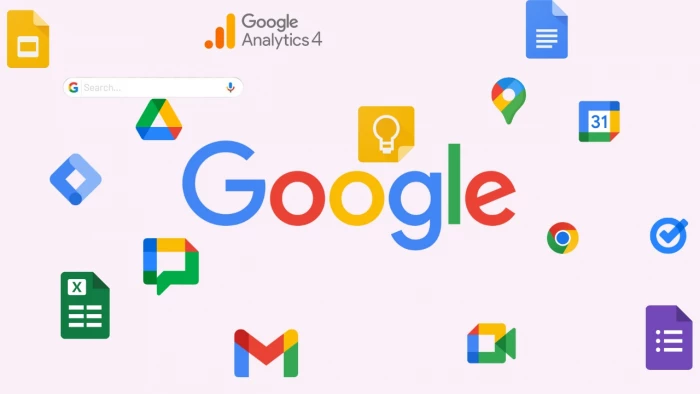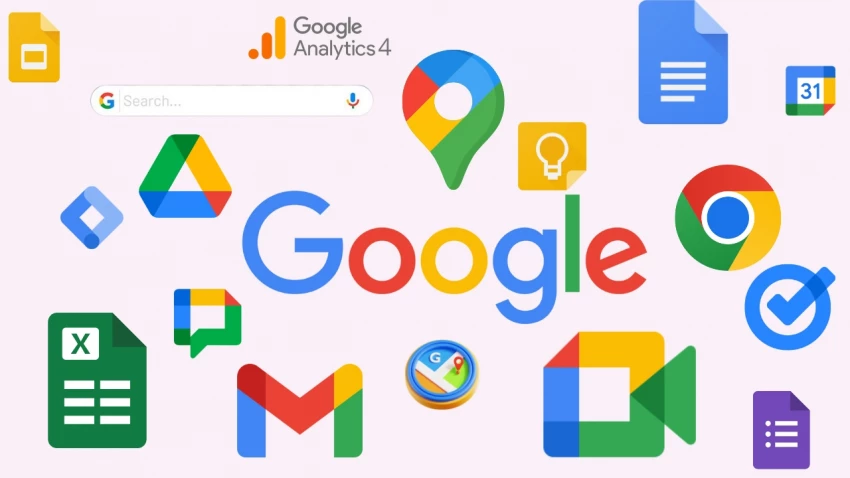

Google has grown from a search engine into an all-in-one powerhouse for work, marketing, and creativity. Whether you’re a freelancer, a small business owner, or running an enterprise, Google offers tools that can boost productivity and marketing efficiency. The key is knowing which ones to use and how to combine them.
In this post, I’ll walk you through 49 of the best Google tools. First, I’ll cover Google-native apps that form the backbone of work and marketing, then I’ll highlight third-party integrations that supercharge those tools. By the end, you’ll know exactly which solutions can help you save time, streamline tasks, and scale your marketing.
Google Search is where it all started. Beyond finding answers, it’s a marketer’s best friend for keyword research, spotting trends, and analyzing competitors. Using search operators like site: and intitle: can uncover insights about your competition and market demand.
As the world’s most popular browser, Chrome does more than load web pages. Extensions like MozBar, Grammarly, and Google Tag Assistant transform it into a productivity and marketing hub.
With over 1.8 billion users, Gmail is more than email. Marketers use it for client communication, automation with filters, and scheduling outreach campaigns. Features like Smart Compose and Nudges also keep you productive.
More than a calendar—it’s a planning tool. Marketers often use it to map out content calendars, schedule campaigns, and sync meetings across time zones.
Cloud storage for over two billion users. Drive allows marketers to share campaign assets, keep documents organized, and collaborate in real time.
Content teams use Docs to draft blog posts, scripts, and reports. Real-time comments and version history ensure no ideas get lost.
A flexible spreadsheet tool. Marketers track budgets, SEO keyword rankings, and campaign metrics here. Add-ons like Supermetrics make Sheets even more powerful.
Perfect for pitch decks and presentations. Marketing teams use Slides to showcase campaign reports and proposals.
An underrated tool for data collection. Forms are useful for lead generation, surveys, and even event registrations.
A lightweight note-taking app that syncs across devices. Great for capturing campaign ideas or jotting down quick notes during meetings.
Integrated with Gmail and Calendar, Tasks helps you track to-do lists directly within your workflow.
This Slack alternative allows internal communication. Teams use it to discuss projects while integrating Docs, Sheets, and Calendar.
A trusted video conferencing platform. Marketers use it for webinars, client meetings, and virtual events.
A digital whiteboard. Perfect for brainstorming campaign ideas or visualizing customer journeys.
A bundled solution combining Gmail, Drive, Docs, Sheets, Slides, Meet, and more. Businesses use it to centralize collaboration.
GA4 tracks web and app performance with predictive analytics. Marketers use it to measure conversions, user journeys, and ROI.
Instead of relying on developers, marketers can use GTM to manage tracking pixels and scripts without touching code.
An SEO must-have. It reveals how your website ranks, which queries drive traffic, and any technical issues blocking performance.
The largest ad platform in the world. Brands use it for search, display, shopping, and YouTube ads. With the right targeting, ROI can skyrocket.
For content creators, AdSense monetizes websites with contextual ads. It’s still a reliable revenue stream for publishers.
An essential tool for PPC and SEO. It provides search volume, CPC, and competition insights.
Trends reveal keyword popularity over time. Marketers use it for seasonal campaign planning or testing content ideas.
Set alerts for brand mentions, competitor activity, or industry trends. It’s a free, easy way to stay ahead.
Local businesses rely on this for visibility in Google Maps and Search. It boosts local SEO and customer reviews.
Although discontinued, it was a powerful A/B testing tool. Many marketers now use alternatives like Optimizely.
Includes Display & Video 360, Campaign Manager, and other enterprise-level tools for data-driven marketing.
Transforms data into dashboards. Marketers create interactive reports combining Analytics, Ads, and social data.
Vital for local businesses. Marketers use Maps to enhance store visibility and run location-based ads.
Great for visual storytelling and location-based campaigns. Nonprofits use it to highlight global impact.

The second-largest search engine. Brands use YouTube for tutorials, ads, and community engagement.
Tracks views, engagement, demographics, and watch time. Marketers use this data to refine video content.
More than storage. Marketers use it to organize visuals and leverage AI-powered search.
Offers free typography for websites and campaigns. Designers use it for branding consistency.
A no-code website builder. Businesses use it for landing pages, team hubs, and project sites.
A no-code platform to build apps from Sheets data. Perfect for automating workflows.
Provides infrastructure, machine learning, and analytics at scale. Enterprises use it for big data and AI marketing.
Let's marketers and analysts run Python notebooks in the cloud. Great for machine learning and advanced data analysis.
Google’s AI assistant. Marketers use it for drafting content, brainstorming, and research.
Turns cameras into search tools. Retailers use it for visual search and shopping experiences.
Offers thousands of add-ons. From CRM integrations to analytics tools, it customizes your workflow.
Connects Google Analytics, Ads, and more with Sheets and Data Studio. Automates reporting so marketers don’t waste hours exporting data.
A CRM built inside Gmail. Perfect for sales teams managing pipelines without leaving their inbox.
Connects Google apps with 5,000+ tools. Marketers use it to automate repetitive tasks like saving Gmail attachments to Drive.
Provides SEO and competitor insights. Its integration with Analytics and Search Console enhances keyword analysis.
Known for backlinks and SEO research. It integrates with Data Studio to enrich reports.
A project management tool that integrates with Google Calendar, Drive, and Gmail. Great for campaign management.
A visual task tracker. It connects with Drive and Calendar to keep marketing projects aligned.
Integrates with Google Drive and Calendar. Teams use it for communication and file sharing.
An inbound marketing giant. With Gmail, Ads, and Analytics integrations, it centralizes customer data and campaign performance.
Google’s ecosystem is vast, but its true power comes when you combine tools strategically. A small business might only need Gmail, Calendar, and Google Business Profile, while an agency might rely on GA4, Tag Manager, and Looker Studio. Add the right integrations, and you can automate tasks, track results, and scale campaigns effortlessly.
You don’t need all 49 tools. The key is choosing the ones that solve your biggest challenges today while leaving room to expand as you grow.
Be the first to post comment!